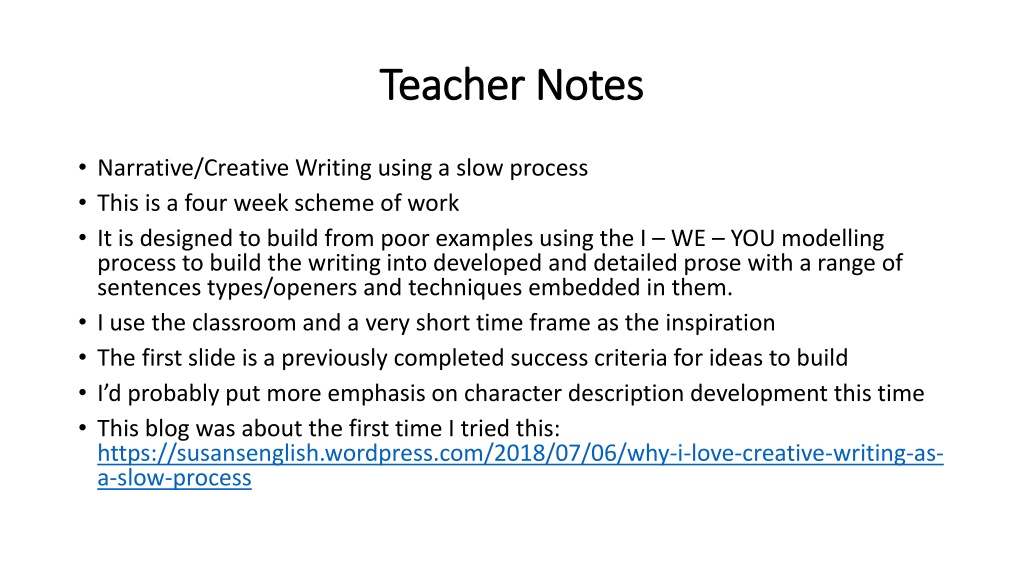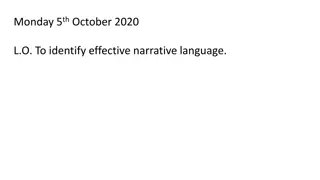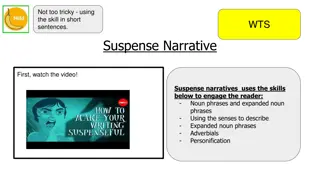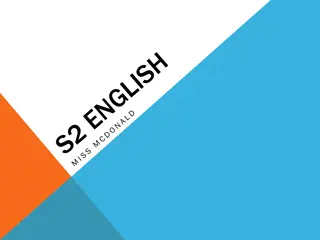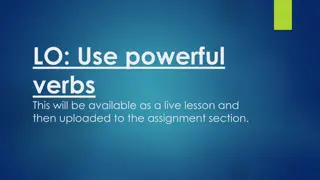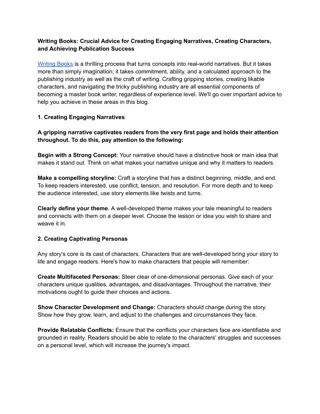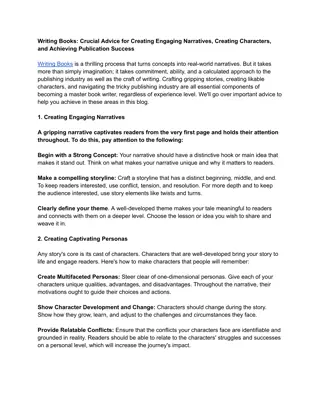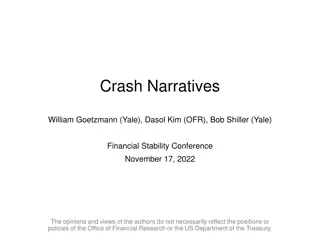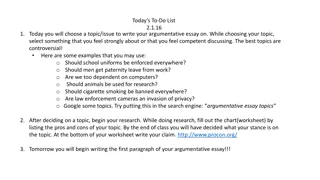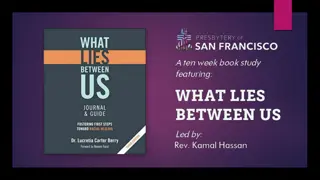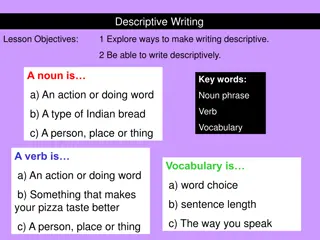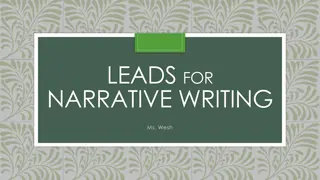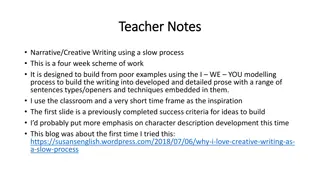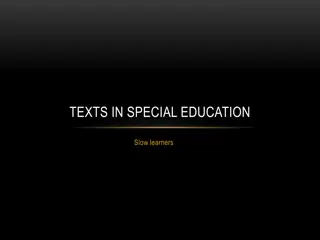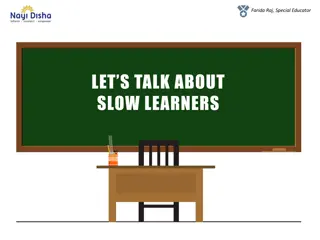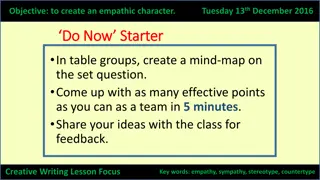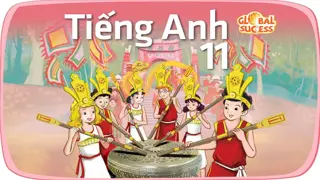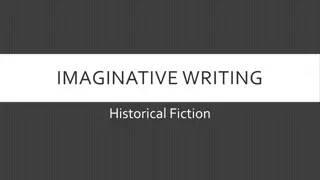Crafting Engaging Narratives Through a Slow Writing Process
Delve into a four-week scheme focused on nurturing narrative and creative writing skills using a deliberate, gradual approach. By starting from rudimentary examples and progressing through the I-WE-YOU modeling process, students learn to enhance their prose with diverse sentence types and techniques. Explore the power of character development, plot structuring, and effective storytelling techniques to engage readers. Utilize creative strategies such as withholding information, using varied sentence openers, and incorporating descriptive elements to create captivating narratives.
Uploaded on Sep 28, 2024 | 0 Views
Download Presentation

Please find below an Image/Link to download the presentation.
The content on the website is provided AS IS for your information and personal use only. It may not be sold, licensed, or shared on other websites without obtaining consent from the author. Download presentation by click this link. If you encounter any issues during the download, it is possible that the publisher has removed the file from their server.
E N D
Presentation Transcript
Teacher Notes Teacher Notes Narrative/Creative Writing using a slow process This is a four week scheme of work It is designed to build from poor examples using the I WE YOU modelling process to build the writing into developed and detailed prose with a range of sentences types/openers and techniques embedded in them. I use the classroom and a very short time frame as the inspiration The first slide is a previously completed success criteria for ideas to build I d probably put more emphasis on character description development this time This blog was about the first time I tried this: https://susansenglish.wordpress.com/2018/07/06/why-i-love-creative-writing-as- a-slow-process
Introduction: How can we make it engaging? Withhold information Short sentences for dramatic effect Question to start Open on a cliff-hanger in the middle of the action Use pathetic fallacy (the weather to set the mood) Show what is happening don t just tell Climax: Dramatic scene Some kind of fight/argument Something needs to happen Something unexpected happens Something naughty The Title: A Memorable Event Conclusion: Needs to link to the rest of your story Be memorable Can resolve the problem or leave it on a cliff-hanger Leave your story with something memorable Use a technique: ellipsis, question or exclamation mark Build Up: Key points for interesting writing: Not to give away too much information Imagery E.g. personification, imagery, simile and metaphor Use the senses throughout How for emotions = use adverbs to develop what feelings you want to create Building a mood using pathetic fallacy Vary sentence starters effectively: no I, the, it, she, he to open Use PANIC for opening sentence starters Preposition, Adjective/adverb, Noun, Ing words, Connective You must self-edit WHOLE STORY: Develop detailed description across the story You want your reader to be engaged with your character/events Check SPAG Sentences are varied simple, complex and compound Check you have not missed words out of the sentence TIPTOP your paragraphs It must be believable and engaging
Lesson 1 - Slow Planning Narrative/Creative Title: A Memorable Event Planning: Overall structure introduction rising action climax resolution Year 10 classroom something must happen it is restricted to one lesson only so the action must happen in the space of 1 hour I will model on the board my planning/thought process for a story with the title memorable event that happens in my classroom. We will discuss some ideas about this type of story and create a group plan. You will come up with your own plan.
Lesson 2 The Power of Nouns Task: Noun words that give names to objects Building an image through nouns showing not telling Stella Artois Fist Tattoos Pub Think What do these nouns make you think and why? Apply Write a character description using these nouns to show not tell what the character is like. Merlot Manicure Handbag Mobile Phone Purse Squash Football Boots Grass Rocking Horse Lullaby Cry Tail Black Ears Meow Wrinkles Doctor Coat - Stethoscope Scarred Long Hair Motorbike Leathers
Lesson 3 - Slow Planning Narrative/Creative Title: A Memorable Event Character Development Explore real examples of character description Annotate how they show not tell Explore what different authors do to create believable and interesting characters Respond: How do authors create interesting characters? How can you embed this in your writing
Lesson 3 - Slow Planning Narrative/Creative Title: A Memorable Event Character Development Success Criteria I will show a poor example of how to do this We will improve the description of character You will create your own character and decide when/how to add this to your introduction or where they will come into your story
Lesson 4 - Slow Planning Narrative/Creative Title: A Memorable Event Introductions Story Openings can use: A statement Dialogue Explore real examples of introductions Explain ways authors introduce their stories Explore what different authors do to create interesting introductions Description of setting and character A question Action Description of setting Description of character Respond: How do authors open introductions effectively? How can you embed this in your writing Intrigue What are the advantages and disadvantages of these types of openings?
Lesson 4 - Slow Introductions Narrative/Creative Title: A Memorable Event Introductions Success Criteria I will model on the board my very bad example of an introduction. We will make it better as a group. We will create a success criteria for a successful introduction. You will use your plan from last lesson and write your introduction including the success criteria.
Lesson 5 - Slow Introductions Peer Assessing Narrative/Creative Title: A Memorable Event Introductions Peer assess Swap your introductions Tick the good points Explain which parts of the success criteria they have used Explain what they need to improve, how to improve and why they need to improve I will go through how to do this We will decide how to be critically analytical in a polite and helpful way You will do this on a partners work make sure you are being critically analytical and helpful in your feedback Next Step: You will improve your introduction by re-writing it and making the improvements your partner asked for Success Criteria
Lesson 6 Vocabulary for emotions Task Learn 3 of the synonyms for each of the emotions Understand define these in your books Apply Write the words in sentences to show you understand what they mean Word spectrum which word is strongest in feeling?
Lesson 6 Vocabulary for emotions Task: E.G Understand - Loathing = a deep seated dislike for someone or something Apply My loathing for marmite knew no boundaries, to me it was a creation from the devil himself, created to disgust me every time.
Lesson 6 Vocabulary for emotions Task: Explain Get together with another student in pairs and explain the synonyms you have learnt, understood and applied. Rate your mate Have they explained well the meaning and embedded in sentences effectively?
Lesson 7 - Slow Planning Narrative/Creative Title: A Memorable Event Rising Action Explore real examples of rising action Explain how authors develop the action or allow their story to unfold Explore what different authors do to create Respond: How do authors build the action effectively? How can you embed this in your writing
Lesson 7 - Slow Rising Action Narrative/Creative Title: A Memorable Event Rising Action Build Up Success Criteria I will model on the board my very bad example of an introduction. We will make it better as a group. We will create a success criteria for a successful introduction. You will use your plan from last lesson and write your introduction including the success criteria.
Lesson 8 - Slow Introductions Self Assessing Narrative/Creative Title: A Memorable Event Rising Action Build Up Self assess Success Criteria Tick the good points Explain which parts of the success criteria you have used Explain what you need to improve, how to improve and why you need to improve I will go through how to do this We will decide how to be critically analytical about your own work without trashing it You will do this on your work make sure you are being critically analytical and helpful in your feedback Next Step: You will improve your rising action by re-writing it and making the improvements you decided on
Lesson 9 - Slow Planning Narrative/Creative Title: A Memorable Event Climax Explore real examples of the climax Explain how authors create this high point in the action Explore what different authors do to create this high point Respond: How do authors create the climax effectively? How can you embed this in your writing
Lesson 9 Climax Narrative/Creative Title: A Memorable Event Climax Success Criteria I will model on the board my very bad example of an climax. We will make it better as a group. We will create a success criteria for a successful introduction. You will use your plan from last lesson and write your introduction including the success criteria.
Lesson 10 - Climax - Peer Assessing Narrative/Creative Title: A Memorable Event Climax Peer assess Success Criteria Tick the good points Explain which parts of the success criteria they have used Explain what they need to improve, how to improve and why they need to improve I will go through how to do this We will decide how to be critically analytical about their work without trashing it You will do this on their work make sure you are being critically analytical and helpful in your feedback Next Step: You will improve your rising action by re-writing it and making the improvements you decided on
Lesson 11 Resolution Narrative/Creative Title: A Memorable Event Resolution Success Criteria I will model on the board my very bad example of an climax. We will make it better as a group. We will create a success criteria for a successful introduction. You will use your plan from last lesson and write your introduction including the success criteria.
Lesson 12 Resolution Self Assessing Narrative/Creative Title: A Memorable Event Resolution Self assess Success Criteria Tick the good points Explain which parts of the success criteria you have used Explain what you need to improve, how to improve and why you need to improve I will go through how to do this We will decide how to be critically analytical about your own work without trashing it You will do this on your work make sure you are being critically analytical and helpful in your feedback Next Step: You will improve your rising action by re-writing it and making the improvements you decided on
Lesson 13 The power of reflecting on vocabulary Vocabulary sharing Read the character descriptions you have been given: What can you borrow? What do you notice? Why is it engaging? Swap books and read at least five of your classmates work. Don t comment. On the post it note write down words or phrases you think are really effective. Share your findings Explain why they are really effective words or phrases. Consider How could you adapt your writing to include these?
Lesson 14 Re-draft Re-write your story in full adapting it to improve it as you do
Lesson 15 Go Blind Apply the combined success criteria to this new title: Write a story about a childhood memory
